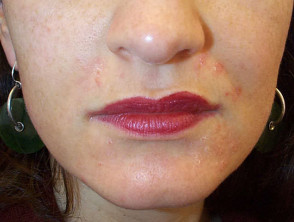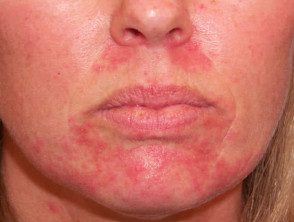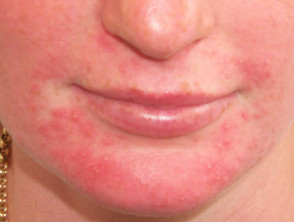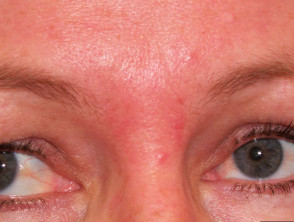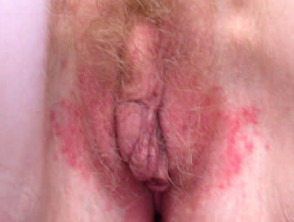DermNet provides Google Translate, a free machine translation service. Note that this may not provide an exact translation in all languages
Home Follicular disorders Perioral dermatitis CME
Follicular disorders
Perioral dermatitis
Created 2009.
Learning objectives
- Recognise and manage perioral dermatitis
Introduction
Perioral dermatitis is a common transient, recurrent or persistent rash affecting the muzzle area, hence its name. However, it often also affects skin adjacent to the eyes or nose, and sometimes around the anus or vagina, where it is more appropriately named “periorificial dermatitis”.
It appears more common in those with fair-skin and is particularly prevalent in women in their 20’s and 30’s.
Clinical features
Perioral and periorificial dermatitis are characterized by clusters of small papules and surrounding erythema. The surface may be scaly, and occasionally vesicles or tiny pustules develop. Typically, in contrast to contact dermatitis, 5-10mm skin adjacent to the vermilion of the lips is unaffected and may appear as a “white” ring. Symptoms vary from none to itch and burning discomfort depending on the severity and extent of the eruption.
Periorificial dermatitis
Unlike acne vulgaris, there are no comedones, cysts, or nodules. The areas affected are distinct from rosacea, which tends to occur a decade or so later and is accompanied by flushing and telangiectasia. However, longstanding perioral dermatitis is sometimes associated with telangiectasia, especially when due to topical steroids.
Perioral dermatitis may be precipitated by:
- Topical steroids – especially potent products
- Inhaled or intranasal topical steroids
- Moisturisers – especially thick ones
- Sunscreens and other cosmetics
- Inadequate face-washing
- Pregnancy or other hormonal change
The cause is unknown – theories include proliferation of commensal fusobacteria or Malassezia yeasts, and hypersensitivity reactions perhaps to sodium lauryl sulphate or an emollient ingredient.
The description “dermatitis” can be misleading – it is not an eczematous dermatitis. Topical steroids make it look better for a day or two, but result in more extensive and more inflamed papules. The most severe cases have always applied topical steroids for weeks or months, and flare severely when these are discontinued.
Treatment
- Avoid oil-based facial creams -use water-based make-up and sunscreen.
- Cleanse face twice daily with mild soap or non-soap non-cream cleanser and water
- Oral anti-inflammatory antibiotics such as tetracycline 250-500 mg, doxycycline 100mg or minocycline 100mg daily for 4-8 weeks. Use erythromycin in pregnancy (if treatment is essential). A longer course may be required for longstanding cases with persistent erythema.
- Topical agents are not very effective and in general are best avoided. However, erythromycin, metronidazole or azelaic acid preparations may be helpful in mild cases.
- If a topical steroid has been applied, warn of a possible flare-up on stopping and if necessary continue a milder product at decreasing intervals over two or three weeks.
Activity
Find out why topical steroids may cause or aggravate perioral dermatitis.
Related information
References:
On DermNet NZ:
Information for patients
Other websites:
- Medscape Reference: Perioral dermatitis
- Merck Manual Professional: Perioral Dermatitis
Books about skin diseases:
See the DermNet NZ bookstore
Sign up to the newsletter
© 2024 DermNet.
DermNet does not provide an online consultation service. If you have any concerns with your skin or its treatment, see a dermatologist for advice.
